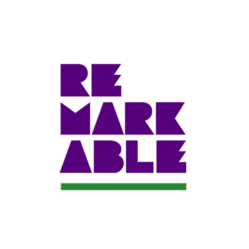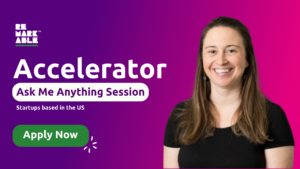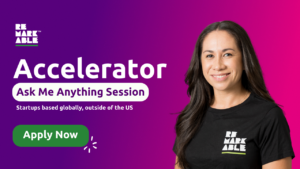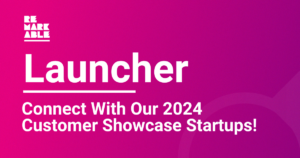Transcript
[00:00 – 00:37] Viv
Just outside of New York the term “Disability Economy” is making its way across the globe and this is thanks to the brilliant work of Professor Jonathan Kaufman.
Born with Cerebral Palsy, Jonathan’s disability has been a profound part of his personal, academic, and professional life and it’s also how he ended up as the former Policy Advisor to the White House on Diversity and Disability and with a column in Forbes magazine.
In the following conversation we dive into the brilliant mind of Jonathan unpacking the concept of the Disability Economy and what this market means for the future of the tech industry.
[00:39 – 00:54] Viv
Jonathan, thank you so much for coming.To start off, I’d love it if you wouldn’t mind doing a visual description of yourself because this will be a video podcast as well. So if you wouldn’t mind just describing what you look like in your setting, that would be wonderful.
[00:54 – 01:20] Jonathan
Sure. You know, at this point I must say, I am now middle-aged. Sort of, I guess, Caucasian man, you know, sort of, I used to have cur- very curly hair, but you know, wavy hair glasses wearing a black t-shirt as I normally do, this is sort of my normal uniform black t-shirts and jeans are sort of my favorite and slightly scruffy, but it’s morning time. So I think it’s always scruffy. Yeah.
[01:20 – 01:47] Viv
Thank you. I’m Viv I’ve got very fair skin and long dark brown hair, and I always seem to be sporting red lipstick but I am so excited to be speaking with you today.You’ve mentioned when we spoke earlier that your, disability sort of colored your life in a way and, the trajectory that you went on from a young age, would you mind speaking to that?
[01:47 – 03:33] Jonathan
No, I talk about it all the time. I mean, I was born what they call the sort of medical terminology is I was born with the right M E paresis, a form of cerebral palsy. And so in, in sort of layman’s terms, it means that essentially. It’s really the left side of my body that works fully. The right side is debatable. And I always think of myself as having two sides and in my house, the right side of my body is called Bob and Bob has a personality of his own. And Bob decides, you know, when he’s spastic, I mean, my significant other always, she always goes, I know when you’re angry because Bob never lies. He sort of takes a mind of his own and has his own personality. So yes, I live with another person that I deal with every day. I mean the truth of the matter is I’ve learned to deal with it. But it’s given me a tremendous amount of gifts. I think. I think my disability is my gift. And so in so many ways it’s been up and down. There’s been moments when you’re sort of thinking about, okay, how do I live day to day when you’re in an insignificant amount of pain? And Iuse humor a lot to hide it, but I always think that’s something that’s good. I understand. Okay, where is my place? And being able to evolve and actually being able to innovate, because the fact of the matter is the world. Like for many people, with different types of disabilities, the world wasn’t designed for us. So we have to figure out, okay, how do we reframe it so that we can, I think, navigate through it.
[03:33] Viv
And, going back to the start of your D and I work. There’s this one story that I love, which you had a surprise lecturer at, your university?
[03:44 – 05:50] Jonathan
Oh, you mean the surprise lecturer at the University of Chicago? Barack Obama. Barack Obama before he was Senator Barack Obama, before he was president of the United States. And, you know, it absolutely sort of shaped my career cause I always thought I would be a full-time academic. At least I thought. And then when I was taking classes with him, it sort of changed the trajectory of how I thought, where my life would go. And really what changed was subsequent to that. I went on to Columbia University in New York. And then he was running for president and all my friends who knew him or knew him said, he’s running. And do you want to be a part of this? And. Subsequently sort of, sort of securitas route. I had heard he was going to create the first advisor to the president on disability policy and lo and behold, I got a call, but the thing was, is I lived in Los Angeles at the time I wasn’t living close. And so I said, yes, And so what ended up happening was that I helped design the policies and the programs and helped train. The person who was actually on sort of, I guess, on location in the white house, around disability policy and politics. And I had a variety of different verticals and different portfolios within the US government And what’s actually even more interesting is that I was on a medical ethics committee at the University of Chicago hospitals with Michelle Obama, who I think is even more fascinating than he is. I mean, he’s a great guy and he was a wonderful professor, but she was really interesting. And just to sort of be with her and get to know how her brain worked and her mind worked was really interesting. So I got to know the Obama family. I mean, this is going back ways into the sort of nine, the, you know, mid to late nineties.
[05:50 – 06:00] Viv
Wow. And, what did, when you are talking about Michelle, it sounds like you, you had a you got to know her in a really special way. What is it that was so impressive about her that perhaps other people wouldn’t know?
[06:00 – 06:23] Jonathan
Well I think people know she was smart as a whip. because it was a medical ethics committee. She had this level of empathy. That was extraordinary. I mean, I think anybody who is on a medical ethics community really has to have that. But it was interesting in terms of her way of negotiating with people and seeing the way that she connected with human beings was, great.
[06:23 – 06:39] Viv
When it comes to policy change, what are the red flags that you see as being sort of the barriers to this change? Is it a majority vote? Is it just a lack of awareness or is it division between parties? What are the real roadblocks?
[06:40 – 08:20] Jonathan
I mean I think initially it is a lack of awareness. Politics do play a role in it. And we’re sort of in this funky time globally and in terms of our political discourse. But I think that initially it’s understanding that we really aren’t that different from one another. And specifically when you’re talking about the disability space, is that look, this is the largest minority on earth and it’s diverse in nature. Which makes it really unique. It runs across free. I always tell my clients and my students that disability is the essence of diversity. It runs across race, ethnicity, gender, socioeconomic, sexual orientation, and it’s the only minority group anyone can join at any time, whether you’re a visitor passing through or whether you’re a permanent resident or it’s the fact that. Not only is this something that’s important as far as from a sort of D&I standpoint, but the value proposition of the community itself impacts everyone. If we’re lucky enough to age, we all join this community. This is an inclusive community by design and that it benefits everyone. If you think about it from the perspective of. Well, we really have to take people with disabilities with all types of disabilities and their narrative into our design processes, whether it be a product or a service or a policy.
[08:20 – 8:56] Viv
I’m curious to know specifically from the point of view of people that have acquired disabilities, how have you seen any sort of trends in your D&I work, where you’ve had to, there’s been people that were employed and then they acquired disabilities and, then all of a sudden employment becomes trickier? Trying to communicate, you know perceptions change for what are just really awful stereotypes and misconceptions about disability that we didn’t judge someone on prior to acquiring a disability?
[08:56 – 11-13] Jonathan
I mean, I think it feeds into the narrative perfectly because I think that the one sort of idea that’s prevalent I always say is the F word, fear. Fear drives that narrative all the time. It’s the fear of the unknown. Rather than saying, okay, let’s get to know it. Let’s get to understand it better so that we can embrace it and say, okay, what do we need as an organization, as an institution to do about it? How do we think about it ? This isn’t about a policy issue, as much as it’s or even a legal issue, which it sort of mired in at times, but it’s really about a design issue. And, you know, it’s fascinating and sort of the age of COVID and we’re gonna be living with COVID when COVID isn’t done, but the silver lining of all of this is that it, was, it sort of, it was an accelerant. In the sense that it accelerated the idea of a hybrid workforce, of the idea of changing the culture of work. And we needed that accelerant, unfortunately, or fortunately, whichever way you sort of look at it, but we needed the accelerant to say, all right, we are now working in a very new time. And yes, there would be some times when you’re sort of in office there’s sometimes when you’re out. Now how does that change the narrative of people with disabilities? It allows them, it allows people with many different types of disabilities to engage in employment. So what you can do is you can say, okay, whether it’s in the D&I, you know, diversity and inclusion, the chief diversity officer and their team, whether it’s in the talent management side or the HR side to say, okay, we understand that this is now a reality.
What one, there are two sides to this; One what do we learn from this community? You know, in terms of needs, in terms of design processes, also the ability to say we can get the best and the brightest. And if they’re working from home, for example, or we have sort of accommodations or design tweaks, we can then. Get people with disabilities involved in the organization at a much faster rate.
[11:17 – 11:40] Viv
It is a massive market now. But in many ways it, sort of always has been, if we look at the technology that is ubiquitous in our life a lot of it was originally born from a need inspired by those with disabilities. Things like, like SMS, which is or texting. Can you think of any other examples of that sort of technology that is ubiquitous with our day to day lives that people probably don’t or perhaps don’t know about?
[11:40 – 13:35] Jonathan
Yeah. I mean, we, you certainly mentioned texting, we talked about that the other day and I always bring that up because that And then, and you think that’s the sort of perfect example is that in 1976 at Gallaudet university in Washington, DC and Gallaudet was known for, it’s like the pretty eminent university for, deaf and hard of hearing. But, it’s like these sort of bastion for deaf culture. So their idea was how do we communicate with one another and. You know, the idea of cell phones was in its nascent stages. And texting became a part of even before the advent of cell phones, but it was adapt. It was adapted for that reason. But even something as simple as what I’m wearing glasses.You know the, advent of glasses in itself. I always tell people when I give it speech, I said, how many of you out there think you have a disability? I said, nobody, somebody, there are people who raise their hand. I said, how many of you have glasses? How many of you take your glasses off for a moment? Can you see? And they’re like, no. So you have to look at glasses themselves as an adaptive tool. We all use adaptive tools in some way, shape or form, it doesn’t matter who we are. It’s part of the human it’s part of the human condition. Actually, I think to use adaptive tools, we can use forks and knives. Those are adaptive tools. So if we’re looking at the history. Of design in any capacity. Human beings have used adaptive tools, whether if you were hunters and gatherers, we were using adaptive tools from the very beginning to live a better quality of life.
So what’s the difference today? Mmm, nothing.
[13:33 – 13:56] Viv
This driving force of nothing about us without us has been huge in the disability advocacy space and really paved a lot of ways for, this understanding of, co-design and, really not making assumptions because that lived experience is critical to getting it right. What is your perspective on that design approach and how it’s transformed over time?
[13:56 – 15:17] Jonathan
Yeah I mean, I actually wrote an article just recently for Forbes. The last article, actually, I said I think we have to rethink the max, nothing about us without us and really think about it. Maybe you should be nothing without us because the fact of the matter is we are a global society. People with disabilities are 20% of the population. Of the global population and is only continuing to grow. And rather than saying nothing about us without us, which is a wonderful statement, But if I think you reframe the model and say nothing with not, you know, you know, nothing without us is that we have, we as a community, have to be, have to have a seat at the table. We have to have a seat at the table for everything. And, why is that important? Because it benefits society, it benefits the sort of financial. And economic prospects of the future. And then there is obviously the diversity piece, but all of this plays into a larger benefit for all. And so that’s really the sort of key driver, I think, for all of this. And I think that’s something that needs to be harnessed again and not only needs to be harnessed. It needs to be expressed again and again until people get it.
[15:17 – 15:39] Viv
So I mentioned earlier that we’d like to sort of wrap these conversations up by asking our lovely guests to share a remarkable insight. And that can range from a fact specifically about the space that you’re super passionate about or it could be a piece of advice or a hope for the future that you would like to leave us…
[15:39 – 17:31] Jonathan
I don’t have a remarkable insight but I always like to tell people, learn from everything and everybody, and everywhere. it’s you almost have to be a sponge because one of the most important things about being alive. Is that there is always something to learn from every experience, whether it be sort of the minutiae of everyday life. I mean, I, you know, I learn from a grocery list to just something that’s so profound, which is watching a great piece of art, you know, whether I think that one of the things that people get caught up in, and in this day in sort of this age of COVID, we’ve all been in this sort of moment of languishing. When we’ve sort of just been standing around, not knowing if we’re depressed and that’s, I think more than reasonable, the last two and a half years have sucked for a lot of us. But now we’re sort of at a moment of reckoning where you have to say, okay, what do we need to do? We’re going to have to live with COVID, but it’s important to learn and important to experience. And what I mean by learn, you can learn from your friends. Which means, you know, start establishing friendships again, start communicating, start engaging with the world around you, because that’s how we learn. That’s how we grow. And so it’s really important I think as human beings to connect and to grow and to learn. And that’s what being alive is about. There’s a wonderful line by William Blake ‘to see the world in a grain of sand and heaven and a wild flower to hold infinity in the palm of your hand and eternity in an hour’. And he wrote that 300 years ago and it still rings true today.
[17:13 – 17:51] Viv
Wonderful, well thank you so much for joining me and sharing all of your insights Jonathan. The full interview with our guest can be found in the link below where you pressed play on this podcast – our show notes. Make sure you subscribe or hit follow to not miss another Remarkable insights episode.
[16:45 – 17:00] Viv
The full interview with our guest can be found in the links below where you pressed play on this podcast, our show notes. Make sure you subscribe or hit follow to not miss another Remarkable Insights episode.
DOWNLOAD A WORD VERSION OF THE TRANSCRIPT HERE.
Watch the full video recording of this podcast here.
Connect with Jonathan Kaufman on LinkedIn and follow his Forbes Column.



